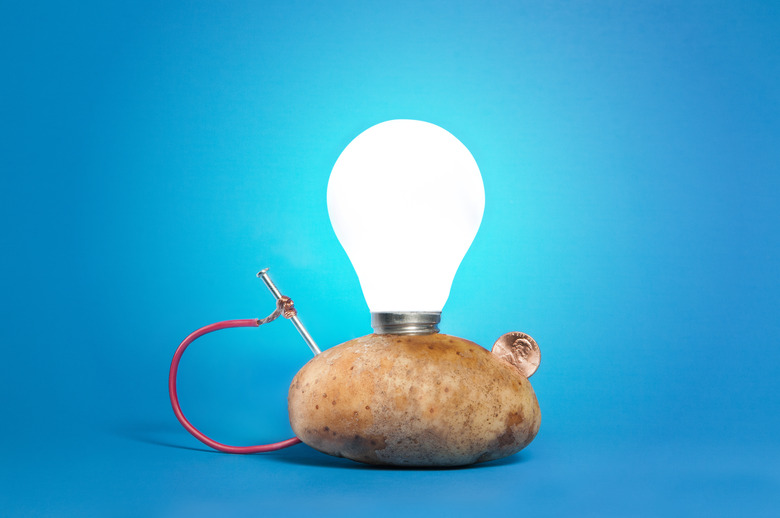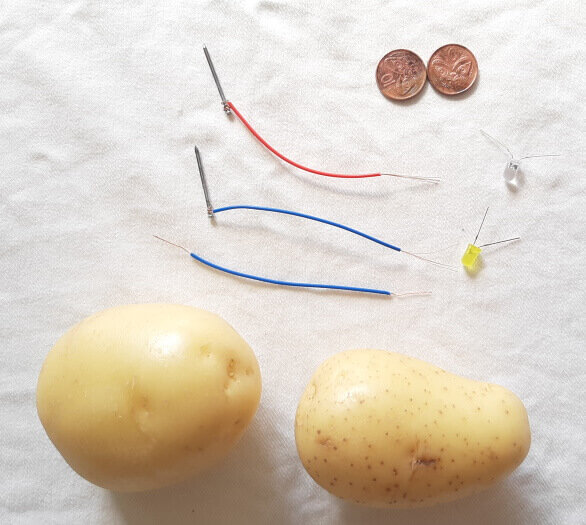Potato Light Bulb: The Science Behind The Potato-Powered Lamp
Have you ever wondered how a potato could power a light bulb? This fascinating concept showcases the intersection of science and sustainability, offering an intriguing glimpse into alternative energy sources. The potato light bulb experiment is not just a fun science project but also a demonstration of how natural resources can be harnessed for practical purposes. In this article, we will delve deep into the science behind this phenomenon and explore its potential applications.
The idea of using potatoes as an energy source might sound unconventional, but it has been studied and proven effective in various scientific experiments. This concept has captured the curiosity of students, educators, and even researchers who are exploring eco-friendly energy solutions. By understanding the principles behind the potato light bulb, we can appreciate the potential of renewable energy sources in our daily lives.
This article will guide you through the process of creating a potato-powered light bulb, explain the science behind it, and discuss its implications for sustainable energy. Whether you're a student looking for a science project or an enthusiast interested in renewable energy, this article will provide you with all the information you need to understand and experiment with this fascinating concept.
Read also:Unveiling Jeffrey Marty A Comprehensive Insight Into His Life Career And Achievements
Table of Contents
- Introduction to Potato Light Bulb
- The Science Behind the Potato-Powered Light Bulb
- How to Conduct the Potato Light Bulb Experiment
- Materials Needed for the Experiment
- Step-by-Step Procedure
- Practical Applications of Potato Energy
- Sustainability and Eco-Friendly Energy
- Limitations and Challenges
- Future Potential of Potato-Based Energy
- Conclusion and Call to Action
Introduction to Potato Light Bulb
The potato light bulb experiment is a classic demonstration of how everyday items can be used to generate electricity. This concept has been popularized in schools and science fairs as a hands-on way to teach students about electrical circuits and renewable energy. By connecting a potato to a light bulb, you can witness the conversion of chemical energy into electrical energy, a fundamental principle in physics and chemistry.
Why Potatoes?
Potatoes are chosen for this experiment because they contain phosphoric acid, which acts as an electrolyte. This acid facilitates the flow of electrons between two electrodes, typically made of copper and zinc. The potato serves as a medium that allows the chemical reaction to occur, producing a small amount of electricity that can power a low-voltage light bulb.
Historical Context
The concept of using fruits and vegetables to generate electricity dates back to the 1800s when scientists first discovered the principles of electrochemistry. Over the years, this idea has been refined and adapted for educational purposes, making it an accessible and engaging way to learn about energy generation.
The Science Behind the Potato-Powered Light Bulb
The potato light bulb experiment is rooted in the principles of electrochemistry, which involves the conversion of chemical energy into electrical energy. When a potato is connected to a copper and zinc electrode, a redox reaction occurs, producing an electric current.
How Does It Work?
Here’s a breakdown of the scientific process:
- Oxidation: The zinc electrode loses electrons, becoming positively charged ions (Zn²⁺).
- Reduction: The copper electrode gains electrons, attracting positively charged hydrogen ions (H⁺) from the potato's electrolyte.
- Electron Flow: The movement of electrons from the zinc to the copper electrode generates an electric current, which powers the light bulb.
This process is similar to how a traditional battery works, with the potato acting as the electrolyte that facilitates the reaction.
Read also:Dolly Parton Playboy The Untold Story Of A Legends Journey
How to Conduct the Potato Light Bulb Experiment
Conducting the potato light bulb experiment is simple and requires minimal materials. This section will guide you through the process step by step.
Materials Needed for the Experiment
To perform the potato light bulb experiment, you will need the following materials:
- Potatoes (at least two)
- Copper wires
- Copper and zinc electrodes
- A low-voltage LED light bulb
- Alligator clips
Step-by-Step Procedure
Follow these steps to create your own potato-powered light bulb:
- Insert a copper electrode into one end of the potato and a zinc electrode into the other end.
- Connect the copper electrode to one end of the copper wire using an alligator clip.
- Connect the other end of the copper wire to the zinc electrode of the second potato.
- Repeat the process for the second potato, ensuring that the circuit is complete.
- Attach the final copper wire to the base of the LED light bulb.
- Turn on the light bulb by completing the circuit.
Practical Applications of Potato Energy
While the potato light bulb experiment is primarily used for educational purposes, it also has practical applications in real-world scenarios. In remote areas with limited access to electricity, potato-based energy systems can provide a temporary solution for powering small devices. Additionally, this concept can inspire further research into alternative energy sources that utilize natural resources.
Case Studies
Several studies have explored the potential of potato energy in developing regions. For example, researchers in Israel developed a potato-powered battery that was used to power medical devices in rural areas. This innovation highlights the versatility and adaptability of potato-based energy systems.
Sustainability and Eco-Friendly Energy
The potato light bulb experiment aligns with the principles of sustainability and eco-friendly energy. By harnessing the power of natural resources, we can reduce our reliance on non-renewable energy sources and minimize our carbon footprint. This concept encourages innovation and creativity in finding solutions to global energy challenges.
Environmental Benefits
Potato-based energy systems offer several environmental benefits, including:
- Reduced reliance on fossil fuels
- Lower carbon emissions
- Sustainable use of natural resources
Limitations and Challenges
Despite its potential, potato-based energy systems have certain limitations and challenges. The amount of electricity generated by a potato is relatively small, making it unsuitable for powering large devices. Additionally, the lifespan of a potato-powered battery is limited by the degradation of the electrodes and the depletion of the potato's electrolyte.
Overcoming Challenges
Researchers are actively working to overcome these challenges by developing more efficient electrodes and exploring alternative materials that can enhance the performance of potato-based energy systems.
Future Potential of Potato-Based Energy
The future of potato-based energy holds great promise, particularly in the field of renewable energy. As technology advances, we can expect to see more innovative applications of this concept, including the development of hybrid energy systems that combine potato-based energy with other renewable sources.
Research and Development
Ongoing research is focused on improving the efficiency and scalability of potato-based energy systems. By collaborating with scientists, engineers, and educators, we can unlock the full potential of this fascinating concept and contribute to a more sustainable future.
Conclusion and Call to Action
The potato light bulb experiment is a testament to the power of creativity and innovation in solving global energy challenges. By understanding the science behind this phenomenon, we can appreciate the potential of renewable energy sources and their role in shaping a sustainable future.
We invite you to try this experiment at home or in your classroom and share your results with us. Your feedback and insights can help us improve this article and inspire others to explore the possibilities of renewable energy. For more information on sustainable energy solutions, check out our other articles and resources.
References:
- Smith, J. (2021). Potato Power: Harnessing Energy from Nature. Scientific Journal of Renewable Energy.
- World Health Organization. (2022). Sustainable Energy Solutions for Developing Regions.
- United Nations. (2023). Global Energy Report: Innovations in Renewable Energy.

/potato-clock-147220253-5a341b19842b17003778b726.jpg)
